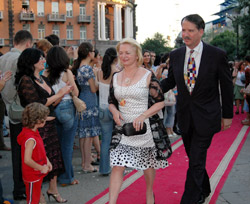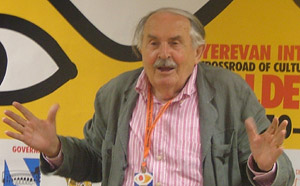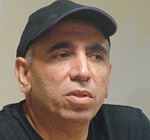
The Poetry of the Golden Apricot
It is said that only the first and the last impressions matter and what is in the middle will be forgotten anyway. But just the opposite happened to the third Golden Apricot International Film Festival.
The first festival, which that took place three years ago, went almost unnoticed. The second one grew into a whole city celebration. The opening ceremony (on July 10) of the third festival was pretty cheerless.
The apricot was blessed in the evening in Charles Aznavour Square after. Then the people gathered had to wait two-and-a-half hours for the guests of honor to arrive. The guests were to walk down the narrow, pink Red Carpet to the Moscow Cinema 's Red Hall, where the ceremony was to take place.
Entry to the hall was by invitation. For the journalists there, the organizers promised to put a screen in the square so that they could follow the ceremony from outside. But no one cared about checking the invitations; nor was the screen set up. Festival program director Michael Stamboltsyan explained, "the people responsible for the screen let us down at the last moment."
 |
 |
 |
Only around 200 people out of the city's more than a million inhabitants were present in the square. The program presenter's voice trembled as he uttered the names of the world famous directors who were walking the Red carpet. But the people there did not show any particular interest in them; in Armenia the name Godfrey Reggio is much less well-known than, say, the name Arnold Schwarzenegger, and the name Zanoussi is much more associated with Italian technologies than with the cinema.
 The situation changed when the president of the festival, director Atom Egoyan and actress Arsine Khanjyan stepped on the Carpet. Journalist and other mortals rushed up to the Armenian-Canadian couple for signatures and questions.
The situation changed when the president of the festival, director Atom Egoyan and actress Arsine Khanjyan stepped on the Carpet. Journalist and other mortals rushed up to the Armenian-Canadian couple for signatures and questions.
The festival opened with a new, digital version of the first Armenian movie, Namus by Hamo-ter-Begnazaryan, made in 1926.
By the way, Gor Vardanyan wanted his movie Destiny to be shown in place of this film. The organizers invited him to show his movie at the festival, because as the festival director Haroutyun Khachatryan noted, "We wanted to have the entire palette of Armenian cinema at the festival." Either the opening or the closing film, insisted Gor Vardanyan. As a result Destiny stayed out of the festival.
 There was a jazz concert and fireworks at the end of the opening ceremony. The metal horses at the square were wrapped in paper and burnt. The wind blew the burning scraps right into the people nearby. Those who got burns moaned a bit; others appreciated the innovation.
There was a jazz concert and fireworks at the end of the opening ceremony. The metal horses at the square were wrapped in paper and burnt. The wind blew the burning scraps right into the people nearby. Those who got burns moaned a bit; others appreciated the innovation.
The slogan of the third Golden Apricot festival was Armenia: the crossroad of cultures and civilizations. 92 films from 58 countries were shown in three categories, Fiction, Documentary, and Armenian Panorama.
Unlike the previous two festivals, this time the organizers of the Golden Apricot gave priority to Armenian Panorama rather than the international films. Whereas the last festival's Armenian Panorama had no fiction, this year eleven fiction films were presented in this category from Armenian directors all over the world.
In every category, films were judged by a jury of five people. Morits de Hadeln was president of the fiction film jury, Godfrey Reggio of the documentary jury, and Arsine Khanjyan of the Panorama.
The main theme of the films was a human being who finds himself in different complicated situations and searches for solutions in them. This year films with women as main characters dominated.
Within the context of the festival, master classes with world famous directors were held; One Day in Europe, dedicated to European cinema was organized; July 14 th , Bastille Day, was dedicated to French cinema; retrospectives of Mohsen Makhmalbaf of Iran and Marko Bellocchio of Italy were shown.
"The festival is an occasion not only to present the new but also to not forget the old," said festival director Harutyun Khachatryan. As part of the festival, an exhibition of posters of old Armenian films was held in the National Gallery.
The festival was also a perfect occasion to communicate with the prominent directors Artavazd Peleshyan, Alexander Adabashyan, Krzysztof Zanussi, Michael Glavoger, Tonino Guerra, Roustam Khamdamov and many others.
It is hard not to agree with the organizers of the festival that keeping their promise to bring such people to Armenia deserves great applause.
Nevertheless the festival was notable for being extremely disorganized. For example, in the press centre of the Golden Apricot, the most probable answer to an every question would be, "We do not deal with that and do not know who does." Or, "Tomorrow at 8 p.m. Mohsen Makhmalbaf will be awarded with the Parajanov Award at the Moscow Cinema right before the showing of his film." Whilst the movie is shown at the Nairi Cinema and there is no single word about the award.
Or journalists go to a film screening which was supposed to be free for them and are told that from now a press pass is no longer enough; they need invitations along with it because the hall is full. And the hall is half empty at the time.
The majority of the films were being translated as they were screened. The translator often would not have time to read the English sentence on the subtitles to the end and would leave the phrase unfinished. The same would occur at the press conferences, and the whole audience would help the translator.
 |
 |
At one of the press conferences, the foreign directors compared the movie to a three-year-old child and asked the journalists to be tolerant to the kid that still had to grow up. They also kept pointing to the festival's ridiculously low budget of US $300,000.
According to the organizers $50,000 of this sum was provided by the Armenian government and the rest by the sponsors. The list of the sponsors, by the way, was endless. The ratio between their number and the low budget is really surprising.
The main problem of the festival, again concerned with the lack of money, was that the technical part was performed by volunteers who had neither any particular experience, nor the wish to improve their work. At that, it was pretty hard to become a volunteer, and even the famous Armenian practice of "pulling strings" was at work as well.
Another problem was the division between the journalists from the sponsor and non-sponsor media. The main sponsor of the festival, the cell phone company Viva Cell, had a condition: with every exclusive interview, TV channels had to play a Viva Cell logo alongside the Golden Apricot logo; all the newspapers had to provide the organizers with 150 copies and magazines with 20 copies of the editions with the interviews. And any online editions were obliged to put Viva Cell logo on their web page. Many journalists complained about this but the festival's art director, Susanna Haroutunyan, noted that that was Viva Cell's condition, and if Viva Cell withdrew from its obligations, there would be no festival at all. As a result, a one-and-a-half-hour interview with Mohsen Makhmalbaf for instance took place with only one journalist present.
The journalists themselves, by the way, did not display any particular courtesy.
 At a press conference with scriptwriter Tonino Guerra, his wife Laura Guerra was pleasant enough to announce that they had not met such a warm and storming welcoming even at the Cannes. The photographers and cameramen, encouraged by this statement, started shooting the Maestro so intensively that signora Guerra asked them to stop because several years ago Tonino had an operation on his brain and the doctors said the camera flash was dangerous for him.
At a press conference with scriptwriter Tonino Guerra, his wife Laura Guerra was pleasant enough to announce that they had not met such a warm and storming welcoming even at the Cannes. The photographers and cameramen, encouraged by this statement, started shooting the Maestro so intensively that signora Guerra asked them to stop because several years ago Tonino had an operation on his brain and the doctors said the camera flash was dangerous for him.
The photographers and cameramen ignored the request and Laura Guerra was forced to shout at them, although this also yielded no result.
 Another thing that Signora Guerra surely never saw at Cannes was the following scene: a cameraman shouts to a journalist across the room, "I have shot enough, let's go, I have lots of other things to shoot!" The journalist nods and takes the microphone in front of Guerra right in the middle of a phrase.
Another thing that Signora Guerra surely never saw at Cannes was the following scene: a cameraman shouts to a journalist across the room, "I have shot enough, let's go, I have lots of other things to shoot!" The journalist nods and takes the microphone in front of Guerra right in the middle of a phrase.
No one can dispute that this action had nothing to do with lack of funding, as did the fact that cell phones never stopped ringing even for a moment.
Although the Maestro noticed and commented on this all, the Guerras maintained a bright and light atmosphere. The author of Amarcord remembered his close friends Parajanov and Mastroiani, told of their funny adventures together with another close friend of his, Fellini.
The joint press conference of Artavazd Peleshyan and Godfrey Reggio was comparatively proper. The American director admitted that it had been the dream of his life to meet the great master Parajanov. He remembered his lectures at Goskino (state cinema) in Moscow. Instead of his payment in rubles he asked the Russians to pay him another way: to show him all movies by Peleshyan on 35 mm film. It was very expensive but his request was satisfied.
"Instead of rubles, I gained the treasure of my life," Reggio said.
He expressed his sorrow that there are no rich men in Armenia who can understand the importance of financing a director like Peleshyan. The great master in his turn told this story: "I was here in March and met with Gevorg Gevorgyan who had just taken the position of minister of culture. He invited me to make a movie at Hay Film . He said that the cinema studio could not provide the entire necessary sum at once, so we agreed on covering the project in three years. He promised to call me and I flew to Moscow. Then someone called me and said he is no longer minister."
The film directors confessed that are worried about the situation with film production in Armenia.
 Mohsen Makhmalbaf offered to create in Armenia a festival like Pussan in Southern Korea. The idea of the festival is the following: every year scripts from different Asian countries are sent here. Then the organizers pass the scripts to the directors and then apply to the producers. Once a year at the festival the directors and the producers meet and discuss the financial side. The necessary sum may be gathered from several producers and the film is shot.
Mohsen Makhmalbaf offered to create in Armenia a festival like Pussan in Southern Korea. The idea of the festival is the following: every year scripts from different Asian countries are sent here. Then the organizers pass the scripts to the directors and then apply to the producers. Once a year at the festival the directors and the producers meet and discuss the financial side. The necessary sum may be gathered from several producers and the film is shot.
"Such a festival in Armenia should to concentrate on Central Asian and Caucasian countries. Let some ten countries participate in the competition, ten films be chosen, one film from each country then to be offered to producers from all over the world. Thus several films will be shot in a year," Makhmalbaf suggested.
The Golden Apricot international film festival ended on July 15. The awards were distributed as follows:
Fiction
Golden Apricot - Jo Siao Tszien, China-France, Three Times
Silver Apricot - Spanish director Isaki Lacuesta, Time Legend and French director Robert Gedikyan, Trip to Armenia.
Documentary
Golden Apricot - Austrian director Michael Glavoger, The Death of a Worker
Silver Apricot - Brazilian Markus Pradu, Estamira and Swiss Gunar Bergal Lyudmila and Anatoli.
Armenian Panorama
Golden Apricot - Hrant Hakobian, The Dwellers of the Forgotten Island
Silver Apricot - Araz Artinyan, Genocide in Me , Vardan Hakobian My Name is Happiness, Maria Sahakyan, Lighthouse.
FIPRESCI award
French-Armenian director Serge Avedikian, To Return
 German director Andreas Dresen, Summer in Berlin.
German director Andreas Dresen, Summer in Berlin.
Tonino Guerra, Mohsen Makhmalbaf, Marco Bellocchio, Godfrey Reggio and Artavazd Peleshyan were awarded the Parajanov award.
Receiving the award, Guerra once again called for being forgiving considering the disadvantages of the just three-year-old festival and said consolingly, "The rich festivals are spoiled with money, but in the poor festivals, there is so much poetry."
Hasmik Hovhannisian
Photos by Elizabeth Brewster, Marc Bagouelin, Mihran Sahakian
 Videos
Videos Photos
Photos




Write a comment